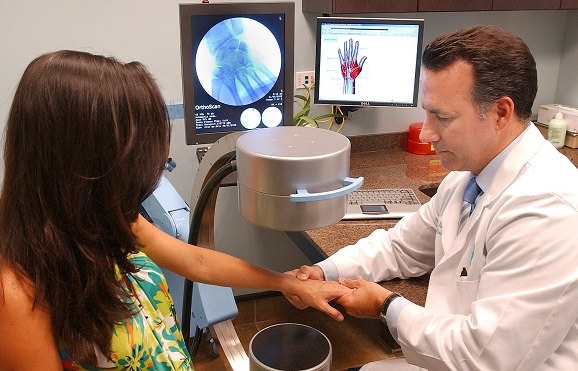Carpal Tunnel Syndrome is an extremely common as well as very misunderstood condition
In recent years, it has received much coverage in the press but this information is often inaccurate and has not been presented by the dedicated hand specialist.
The media has branded this condition as an occupational disease because of workers linking pain in their hands to repetitive activities such as typing or assembly line work. Despite popular opinion, this condition is not caused by using a keyboard. However, if one has a predisposition to this condition, repetitive activity such as typing can aggravate it.
Carpal Tunnel Syndrome simply means that there is a compression of the median nerve in the hand. This nerve sits inside a tunnel in the hand whose floor and walls consist of bones known as carpal bones. The roof of this tunnel is a structure called the transverse carpal ligament.
Carpal Tunnel Syndrome: symptoms and diagnosis
The symptoms most often reported with Carpal Tunnel Syndrome are numbness and tingling in the hand which often begins at night. Often there is also pain and weakness in the hand, particularly in the thumb. If allowed to progress for many years untreated, this could lead to atrophy of the muscles in the base of the thumb.
Besides the physical symptoms of Carpal Tunnel, the diagnosis is easily confirmed by a simple nerve conduction study. This measures the velocity and the latency of the nerve impulse across the median nerve at the wrist and can tell the physician if the patient has a compression of the median nerve.
The treatment for Carpal Tunnel Syndrome
It is often directed at decreasing the inflammation of the tendons. Injections of steroids such as cortisone can lead to a decrease in the swelling. This will allow the median nerve more room in the carpal tunnel and relieve the pain.
The most common treatment without the use of drugs or injections is a night splint. The splint does not allow the patient to flex their wrist at night which often occurs during dreaming. This relieves some of the pressure within the canal. Symptoms are magnified at night because the position of the hand is at the same level of the heart while lying down leading to pooling of the fluid in the soft tissues within the canal.
If the compression is severe enough and the patient does not respond to conservative treatment, the next step would be a minor procedure. Surgery for Carpal Tunnel Syndrome is also misunderstood by the public as well as many physicians. Rumors abound as to the final outcome after these procedures. People think they can lose function of their hand if they have surgery. The truth is that surgery is extremely successful.
This procedure actually entails a very simple concept. A division is made in the ligament which serves as the roof of the carpal tunnel. This increases the space in the carpal tunnel allowing the median nerve to function better.
Endoscopic release
The most recent breakthrough in treatment of Carpal Tunnel Syndrome, which is used at the Surgery Center at Doral, is called endoscopic release. In this procedure, an incision of less than one centimeter is made in the crease of the wrist and an endoscopic, a tiny camera, is inserted. This allows the surgeon to literally see the inside of the hand and make the division of the ligament without a large, open incision.
The key to understanding Carpal Tunnel Syndrome is to think of this as a pinched nerve which occurs in the wrist and leads to symptoms such as numbness or tingling. These are many painful conditions in the hand and wrist which need to be evaluated by a surgeon specializing in such problems.
Carpal Tunnel Syndrome is an easily diagnosable and treatable condition when evaluated by the appropriate type of physician. If you have pain in your hands, take heart, don’t quit your typing job. Contact Badia Hand to Shoulder Center for a consultation, including a simple nerve study, and free yourself from this unnecessary pain.
For more information regarding Carpal Tunnel Syndrome one can read more on this topic or view videos at www.drbadia.com and for further orthopedic topics, see www.orthonowcare.com
Alejandro Badia, MD, FACS
Hand and Upper Extremity Surgeon
Badia Hand to Shoulder Center
www.DrBadia.com
Co-founder/Chief Med Officer, OrthoNOW Immediate Orthopedic Care Centers









Leave a Reply